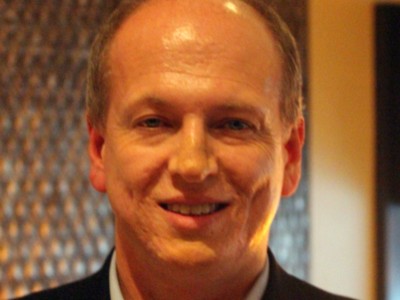Fiserv demonstrates Google Glass banking

Banking technology developer Fiserv today demonstrated mobile banking via Google Glass and Samsung's Gear smartwatches, alongside other mobile payment technologies already being implemented by some of its 1800 financial services customers,
In Auckland, Fiserv SVP and general manager of digital channels Jim Tobin said around 10 million people now use its mobile banking and payments technologies, but 60 million use its products online. That leaves 50 million existing customers as immediate candidates for mobile banking.

Tobin said five years ago, banks were investing "five figure sums" in their mobile projects. This year, Bank of America revealed it had invested $500 million.
"We see enormous growth," he says. "It's not a market that's close to peaking."
The Google Glass and Gear applications run totally on the wearable device and only use a phone to provide connectivity. Users can check balances and make payments via voice command, but functionality is only limited by the wearable device's own capabilities, says Kieran Waelen. the Fiserv product manager who conducted the demonstrations.
Tobin says US credit union America First has implemented online car and home loan applications via Fiserv's New Zealand developed Mobiliti platform. A customer can take a picture of the car's vehicle identification number and apply for and receive approval for a loan totally from their mobile phone.
America First customers can also receive special retail offers and transact through their phones without coupons. Discounts used can be automatically deposited back into their accounts.
Nasdaq-listed Fiserv also demonstrated a new augmented reality application for such push offers, allowing users to look around with the camera's viewfinder and GPS to visually see where deals were available in their proximity.
Waelen described that as a "transformative experience".
Mobile can also be used to eliminate steps in the banking process. Already many customers can check their bank balances with a single touch, however, using voice activation a customer can now say "I want to make a payment", taking them not just to their banking application, but straight to payments.
Fiserv is also shifting much of its existing online functionality to mobile. For instance, credit cards will be able to be managed by mobile and, if lost, blocked and unblocked without being cancelled. Employee credits cards can have policies attached, allowing them to only be used, for instance, in a specific geographic area or for limited classes of spending.
Employers can already use alerts to manage behaviours such as excess company card spending, while consumers can use them to avoid overdrafts - and overdraft fees.
It is not necessarily safe to assume Near Field Communications (NFC) will command the mobile payments landscape, says Fiserv's Ed Massey, CTO of digital channels.
Apple could turn NFC on its head as soon as it enters the market, he says. Amazon also has the capacity to bypass NFC by, for example, using GPS to sense presence and completing transactions wirelessly via a credit card.
The likes of Amazon could threaten banks because it already knows so much about so many customers, says Tobin. However, banks have an advantage in higher trust ratings and should use it while it lasts.
In Asia and the Pacific, Fiserv has partnered with ANZ and Cambodia's ACLEDA Bank to deliver mobile services to the "unbanked", people with no bank accounts or sometimes no bank access. Funds can be texted from one person to another and even withdrawn from an ATM via a one-time PIN number.
In Cambodia, users used to send money in cash by taxi, Massey says. It was expensive and sometimes it didn't arrive.
The service spreads virally as texts are exchanged and does not even require a smartphone.
Tobin says mobile payments increases the touchpoints banks can have with their customers and therefore increase marketing opportunities. People carry their mobile phones with them everywhere, so it is the ideal device for transactions, he says. Youth, in particular, is already preferring the mobile channel to others.
Mobile is also increasingly coming first, becoming the channel where bank customers are first signed up, overturning the perception initiation would always happen in a branch before the customer used online or mobile banking tools.
Fiserv's mobile applications are based on technology developed in New Zealand by mobile payments developer M-Com, which Fiserv bought in 2011 for an undisclosed sum. Records since released at the New Zealand Companies Office reveal the purchase price was NZ$64 million.
Tobin now describes the technology as Fiserv's "crown jewels".
When M-Com was bought it had around 40 staff in New Zealand. Fiserv now has around 300 there. Tobin says New Zealand's receptitivity to immigration makes it a good environment for technology companies.